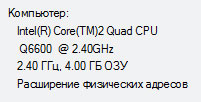4GB of RAM

For quite a long time I thought about which blog to post it to, and never did.
The described problem at one time deprived me of the mass of nerve cells, and in the future (the prices for the operating system will fall) only more people will encounter it, so I decided to share everything I know.
The problem is simple: you put 4 gigabytes of RAM into the computer, but the operating system did not appreciate your generosity.
A little thought, you remember that your OS is 32-bit, hence the addressable space is 4GB. The trouble is that it takes not only RAM, but also other devices. Including a video card. And so, from your four gigabytes remains at best three and a half. Offensively? It's a shame.
')
I want to immediately upset. 32bit XP and Vista with any tambourine do not want to see anything except their 32bit.
Crossroads
You get a choice:
- To score and live with this is the least thorny path, IMHO
- Put 64bit axis - after all, 64bit systems still have compatibility problems. Having cured one, cripple another.
- Installing a 32bit server is what I’m going to talk about in more detail about it.
PAE
What is magic in Windows 2003 Server Enterprise? She can fully use PAE (Physical Address Extension). In XP, it also exists, but since SP2, it does not expand the address space in the interests of compatibility and is used only to support the operation of DEP. This technology allows you to use 36-bit addressing to access addresses that get out of 4 gigabytes. Supported by processors starting with Pentium Pro.
Yummy? Yes. With PAE, Windows can use a fairly substantial amount of memory, while remaining 32-bit. However, applications will still be allocated 2GB of virtual address space. This means that using a lot of resource-intensive programs you will feel the gain. And if you want to "feed" Photoshop - then nothing will change.
PAE also adds AWE technology. It allows the program to bypass this restriction by moving the two-window “window” in the address space. However, alas, most applications do not support this technology, so you may not think about it. Razve that MSSQL Server, but on it photoshop will not work.
upd: fixed (07.20.2009)
Problems
Quite rosy? Early rejoice. Do not forget, this is still a Windows 2003 server . All disabled multimedia features will easily turn on, this is not a problem. And the system will be iron stable. But you will encounter a mass of principled manufacturers who like to check versions, but who do not like your system. For example, HP, Logitech ( just a few days ago ). Fortunately, with the help of a tambourine (compatibility mode and Application Verifier) you will completely make everything work.
True, if some program gets into the memory of the kernel, then it runs the risk of being surprised , apparently not finding half. One of them is the Source engine. My portal is launched once every other time ...
Also, some drivers in theory may not work correctly.
However, I have been living with this for the third month, and I am quite happy, without experiencing practically any problems. I have never seen a blue screen yet, pah-pah.
Okay, so how does this PAE apply?
The guys from Microsoft explained everything quite well: support.microsoft.com/kb/283037
But just in case I will add: in addition to the PAE key, you may need to enable the option of memory remapping in the BIOS. I found it in my chipset settings.
More to read
www.microsoft.com/whdc/system/platform/server/PAE/PAEdrv.mspx
www.microsoft.com/whdc/system/platform/server/PAE/pae_os.mspx
www.ixbt.com/soft/windows-4gb.shtml - a very cool article on the topic, gotch tossed
upd: Made some corrections.
Source: https://habr.com/ru/post/20179/
All Articles